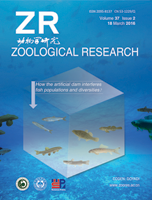
|
Zoological Research
Kunming Institute of Zoology, Chinese Academy of Sciences
ISSN: 2095-8137
Vol. 36, No. 1, 2015, pp. 1-17
|
 Bioline Code: zr15001
Bioline Code: zr15001
Full paper language: English
Document type: Research Article
Document available free of charge
|
|
|
Zoological Research, Vol. 36, No. 1, 2015, pp. 1-17
| en |
Genomic organization and evolution of ruminant lysozyme c genes
IRWIN, David M.
Abstract
Ruminant stomach lysozyme is a long established model of adaptive gene evolution. Evolution of stomach lysozyme function required changes in the site of expression of the lysozyme c gene and changes in the enzymatic properties of the enzyme. In ruminant mammals, these changes were associated with a change in the size of the lysozyme c gene family. The recent release of near complete genome sequences from several ruminant species allows a more complete examination of the evolution and diversification of the lysozyme c gene family. Here we characterize the size of the lysozyme c gene family in extant ruminants and demonstrate that their pecoran ruminant ancestor had a family of at least 10 lysozyme c genes, which included at least two pseudogenes. Evolutionary analysis of the ruminant lysozyme c gene sequences demonstrate that each of the four exons of the lysozyme c gene has a unique evolutionary history, indicating that they participated independently in concerted evolution. These analyses also show that episodic changes in the evolutionary constraints on the protein sequences occurred, with lysozyme c genes expressed in the abomasum of the stomach of extant ruminant species showing the greatest levels of selective constraints.
Keywords
Lysozyme c; Ruminants; Gene family; Gene duplication; Concerted evolution; Mosaic evolution
|
| |
© Copyright 2015 - Zoological Research
Alternative site location: http://www.zoores.ac.cn/
|
|
